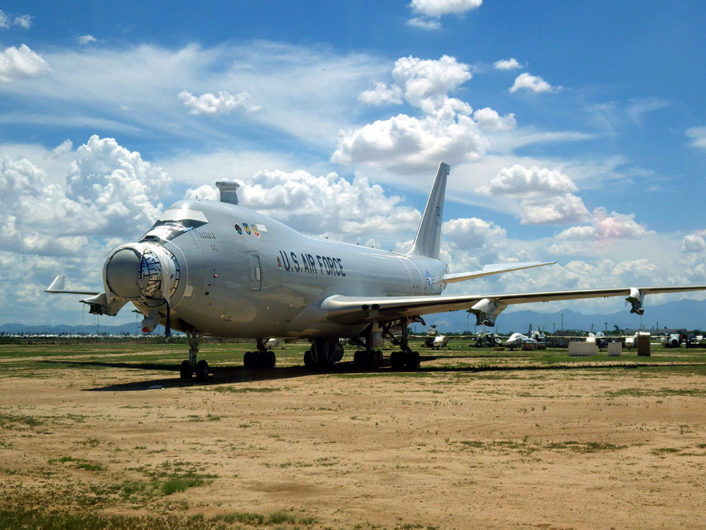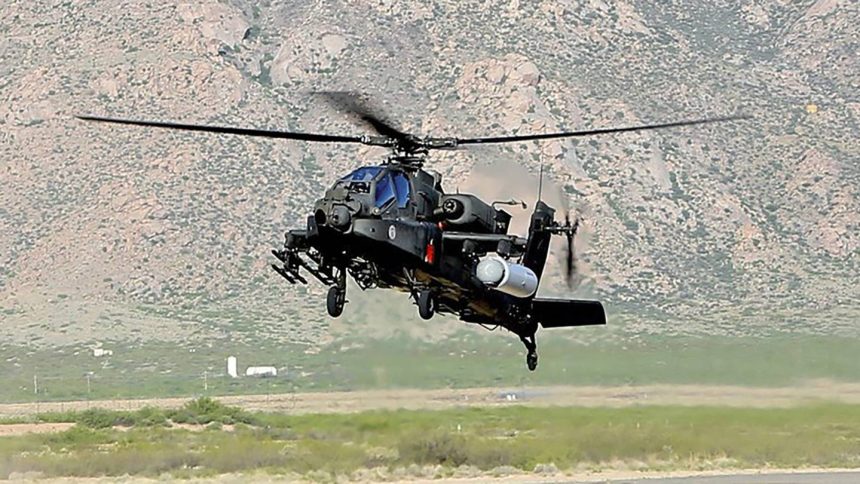High Energy Weapon Shows Potential in Effectiveness and Precision In Anti-insurgent Operations But May Be Vulnerable to Countermeasures.
U.S. defense contractor Raytheon conducted a successful, highly publicized, precision firing of a weaponized laser weapon from a U.S. Army AH-64 Apache attack helicopter on Jun. 26 at the White Sands Missile Range in New Mexico, western United States.
The test firing was conducted in collaboration with the U.S. Special Operations Command (SOCOM). This association may provide some insight into the intended operational role of High Energy Lasers in a tactical setting.
While the test itself is noteworthy since it is the first time a High Energy Weaponized laser has been fired from an attack helicopter to attack a target, the use of tactical lasers for range-finding, target designation and guidance are already commonplace in militaries around the world.
What makes Monday’s Raytheon test particularly interesting is the new ways a weaponized laser, not just a laser designator, could be used for precision attack and reduction of collateral damage.
Laser, or “Light Amplification by Stimulated Emission of Radiation” is effectively a narrow beam of powerful radiation that burns things. Think of it as a long-range, needle-nosed flame thrower but without visible fire, only heat (or light) energy. In fact, the Raytheon test was visibly quite unremarkable. There was no giant eruption of flames, no bright “death ray” and no explosions on glowing red targets. This invisible, silent, sinister quality may be what makes the laser Raytheon laser weapon fired from the Apache all the more menacing, especially to insurgencies that do not have effective technology to counter the weapon and can’t even tell when they are being targeted until it is too late.
Picture a lone insurgent trying to emplace an Improvised Explosive Device on a roadside. Without warning, the device simply incinerates before their eyes. No explosion unless the munitions are detonated by the laser energy, no sound, no trace of where the “weapon” came from. A mile away an attack helicopter or RPV (drone) silently hovers, firing its death-ray. The IED is simply rendered inoperable. Seconds later Special Operations personnel arrive to detain the insurgent bomber. There are no casualties and no collateral damage. Nearly all intelligence materials are preserved.
This high-precision capability is attractive to anti-insurgent operations that typically involve relatively close range engagements on very small targets, often as small as a brief case or even smart phone. If the targeting optics on the delivery vehicle, in this case an AH-64 Apache helicopter, can see a target, they can direct the laser weapon onto it precisely.
But laser weapons are not entirely infallible. Recall that laser is focused light, and that can be reflected or absorbed. The Chinese military has already devoted substantial research to both laser weapons and laser weapon countermeasures.
The Chinese developed and proven the capability of their own JD-3 and ZM-87 laser weapons. These weapons feature “less than lethal” capability at long ranges, and greater lethality at close range. The Chinese ZM-87 weaponized laser can permanently blind personnel at 2 to 3 kilometers and temporarily blind them out to 10 kilometers. Laser weapons specifically intended for blinding personnel were banned in a 1995 United Nations Protocol that may or may not be observed by nation-users in an armed conflict.
The Chinese JD-3 laser weapon is specifically intended to counter laser target designation and range finding from an enemy force- it fires a laser back at an attacking guidance laser to disrupt and destroy it. Both Chinese lasers have, according to recent intelligence, been ground vehicle mounted. But China is busy developing an indigenous attack helicopter capability with their new CAIC Z-10 and Z-19E Black Whirlwind aircraft, and it is reasonable to suggest both the ZM-87 and the JD-3 could be used from one of the new Chinese attack helicopters in a way similar to this week’s test in the U.S.

(Photo: Tiexue.Net)
Most recently the Chinese unveiled a promising new laser weapon at an arms trade show in Abu Dhabi in early March of this year. This new Chinese laser weapon follows their “Low Altitude Guard II” system deployed as an anti-drone weapon and is claimed to be able to intercept and destroy incoming mortar and rocket munitions in flight. These systems have been attributed to a combined research and development project of the Chinese Academy of Physics Engineering and the Jiuyuan Hi Tech Equipment Corporation.
In any conversation about laser weapons anti-laser defenses are among the greatest concerns, although likely not with insurgent adversaries who may lack resources to develop a fieldable anti-laser capability. Mirrors do little to reflect enough laser energy quickly enough to stop the weapons’ effects. Advanced composite material, heat and light absorbent coatings may provide additional protection but are expensive and difficult to field.
Beginning in 2014 Israel showed it developed and successfully tested the “Iron Beam” anti-missile laser weapon built by Rafael Advanced Defense Systems. The system compliments the highly successful Iron Dome anti-missile system already operational. Iron Beam has a reported range of 7 kilometers and has been successful in destroying incoming mortar rounds and artillery projectiles, particularly difficult targets because of their small size and high speed. No information has been recently published about the operational deployment, if any, of Iron Beam.
Finally, while the new Raytheon/AH-64 Apache laser weapon test is noteworthy, it is far from a first.
In 2002 a militarized Boeing 747 called the YAL-1 was equipped with a massive airborne laser weapon intended to destroy ICBMs in flight. The ambitious anti-missile laser system was first fired in 2007 but the program was ended in 2011 for a number of reasons including the unfeasibility of the large aircraft operating safely in close proximity to enemy ICBM launch facilities. The system simply made too large and vulnerable of a target since it had to be relatively close to the missile it was trying to destroy. It remains one of the most expensive defense projects in history.
On Feb. 14, 2012, this writer got to see the YAL-1 make its final flight into Davis-Monthan AFB in Tucson, Arizona for storage and dismantling at the 309th Aerospace Maintenance and Regeneration Group (AMARG), the famous “Boneyard”.

(Photo: USAF)
While laser weapons are not new this more recent test by Raytheon and the U.S. Army in cooperation with SOCOM may suggest a new niche application for laser weapons in the continuing anti-insurgency war. Depending on how quickly the capability can be fielded this may be a promising test result for the U.S. as it enters yet another chapter in the continuing Global War on Terror.









